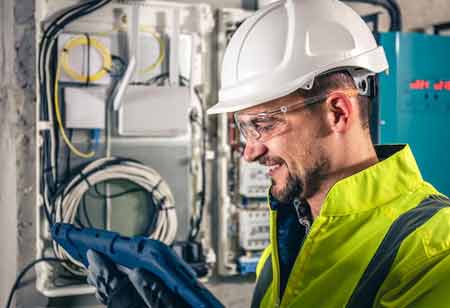Thank you for Subscribing to Electrical Business Review Weekly Brief
I agree We use cookies on this website to enhance your user experience. By clicking any link on this page you are giving your consent for us to set cookies. More info
Electrical Enclosures: Safeguarding Power and Performance in the Electrical Industry
Embracing innovations and adopting smart and sustainable enclosure solutions will pave the way for a safer, more reliable, and more efficient electrical future.

By
Electrical Business Review | Friday, August 22, 2025
Stay ahead of the industry with exclusive feature stories on the top companies, expert insights and the latest news delivered straight to your inbox. Subscribe today.
FREMONT, CA: In the realm of electrical systems and installations, ensuring safety, protection, and reliability are paramount. Electrical enclosures are critical in safeguarding sensitive equipment, control systems, and power distribution components from environmental factors, physical damage, and potential hazards. This article explores the significance of electrical enclosures and how they contribute to the seamless functioning and longevity of electrical installations in various industries.
The Importance of Electrical Enclosures
Electrical enclosures are protective cabinets or boxes designed to house electrical equipment, like circuit breakers, switches, relays, and power distribution components. These enclosures serve multiple essential functions:
1. Safety and Protection: Electrical enclosures provide a barrier between electrical components and the external environment. They safeguard equipment from moisture, dust, chemicals, and other environmental factors that could induce damage or compromise performance.
2. Preventing Accidents: Enclosures prevent accidental contact with live electrical parts, reducing the risk of electric shocks and assuring the safety of personnel working on or near electrical systems.
3. Security: In industrial and commercial settings, electrical enclosures help prevent unauthorized access to critical electrical equipment, ensuring that only authorized personnel can modify or adjust.
4. Compliance with Codes and Standards: Electrical enclosures are designed to fulfill specific industry standards and regulations to ensure that electrical installations are safe and comply with relevant codes.
Types of Electrical Enclosures
Electrical enclosures come in various types and materials, each catering to specific requirements and environments:
1. Metal Enclosures: Steel and aluminum enclosures offer robust protection and are commonly used in industrial applications. They are highly durable, corrosion-resistant, and suitable for outdoor installations.
2. Non-Metallic Enclosures: Made from materials like polycarbonate or fiberglass, non-metallic enclosures are lightweight, impact-resistant, and ideal for corrosive environments.
3. Wall-Mounted Enclosures: These enclosures are designed to be affixed to walls, offering a space-saving solution for housing electrical equipment.
4. Floor-Mounted Enclosures: Floor-mounted enclosures are freestanding units that provide ample space for housing larger electrical components and systems.
Applications of Electrical Enclosures
Electrical enclosures find applications across various industries, ensuring the reliability and safety of electrical systems:
1. Industrial Automation: In industrial settings, electrical enclosures house control panels, motor starters, PLCs (Programmable Logic Controllers), and other automation components.
2. Power Distribution: Enclosures house circuit breakers, distribution boards, and switches, ensuring efficient and safe power distribution.
3. Renewable Energy: Electrical enclosures play a vital role in protecting solar inverters, wind turbine controls, and battery storage systems in renewable energy installations.
4. Data Centers: Enclosures are crucial in data centers, safeguarding servers, switches, and networking equipment, vital for seamless data processing and communication.
The Future of Electrical Enclosures
As technology advances and industries evolve, electrical enclosures are also undergoing innovations to meet the changing demands of the electrical industry:
1. Smart Enclosures: Integrating sensors and monitoring devices into enclosures allows real-time tracking of environmental conditions, equipment status, and potential faults.
2. Environmental Sustainability: Enclosure manufacturers are exploring eco-friendly materials and designs to promote sustainability and reduce environmental impact.
3. Modularity and Customization: Enclosure designs that offer modularity and flexibility allow for easier customization to fit specific equipment and layout requirements.
Conclusion
Electrical enclosures play an indispensable role in the electrical industry, safeguarding vital equipment and systems while ensuring safety, protection, and compliance with regulations. As the world increasingly relies on electricity, these enclosures' importance continues to grow. Embracing innovations and adopting smart and sustainable enclosure solutions will pave the way for a safer, more reliable, and more efficient electrical future. Whether in industrial plants, commercial buildings, or renewable energy installations, electrical enclosures are steadfast guardians of power and performance in the electrical world.








